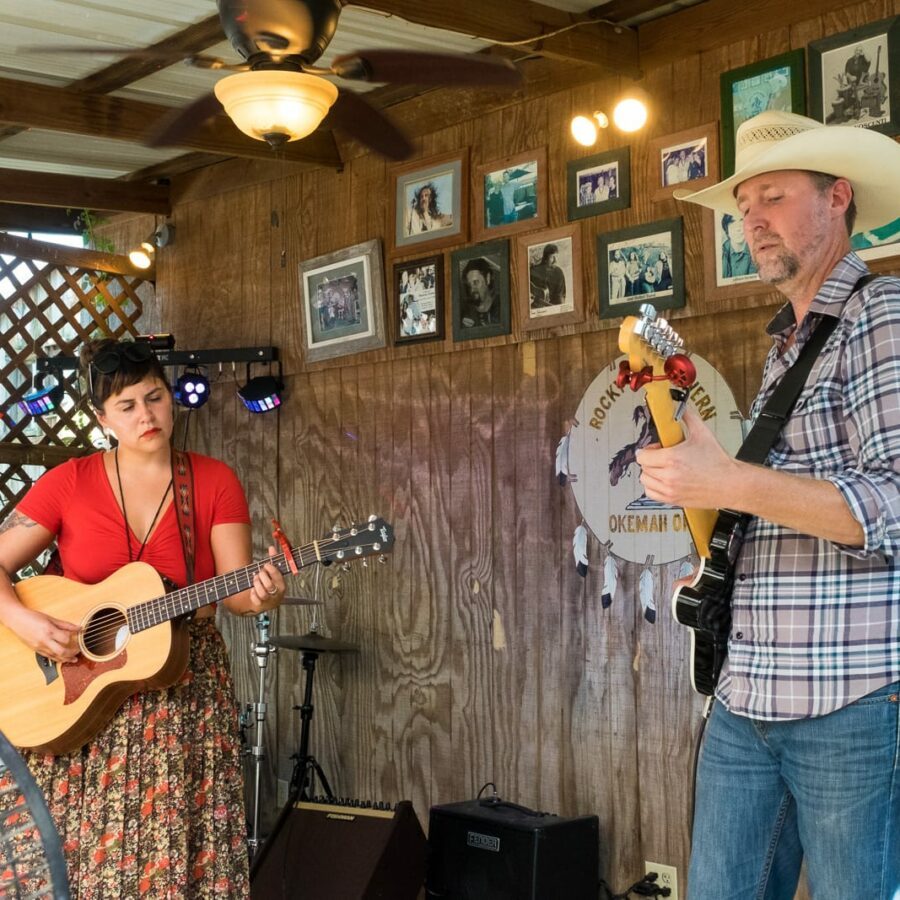
Woodyfest 2018: Kalyn Fay
Tsa-La-Gi Songstress
Expat-Tulsa Singer Returns to Woodyfest
Your humble author [Sidenote: This is the nineteenth installment in our ongoing series on the 21st Annual Woody Guthrie Folk Festival, featuring singer-songwriter Kalyn Fay.] first met musician Kalyn Fay in when journalist Nathan Poppe brought her to the Bureau’s studio. She had come to sit as one of the earliest subjects for OKIE-X: Portraits of Oklahoma Musicians on X-Ray Film, an ongoing Bureau project. I had not heard her music at the time; my recollection is that John Calvin Abney suggested I invite her to sit.
The next time I saw her was during one of Woodyfest’s infamously rained-out opening days. The “Muddyfest” saw a toad-strangler of a , forcing the closure of the outdoor Community Improvement Association (CIA) stage and the main stage at the Pastures of Plenty. Fay was scheduled to be the third performer at the CIA stage, but the rain started . So the powers-that-be moved her to the upstairs dining area of the Brick Street Café — the basement stage was already in use as a festival venue, as it has been most years. [Sidenote: The Brick was closed during the Woody Guthrie Folk Festival.]
Fay did her best despite being more than a little damp. Abney accompanied her on guitar and occasionally provided vocal harmonies. Despite everyone being out-of-sorts from the weather, festival-goers received her warmly, patiently waiting for the many re-tunings the humidity necessitated. I found myself battling with condensation in all of my camera lenses, even though they and the camera bodies are weather sealed.
Returning for her third Woodyfest appearance, Fay played an set at Lou’s Rocky Road Tavern. A longtime unsanctioned-but-popular festival venue, this marked the Tavern’s first year as an official performance space. Festival-goers could not have asked for a better singer to usher in the stage’s newly accredited status. Playing a mix of old material and new, the singer had even the most fidgety audience members sitting quiet and still.
Fay was accompanied by guitarist Stephen Lee. Lee is a familiar face on the festival stages, adding his licks to many a performance. You could call him a pinch-hitter of the guitar. Tulsa bandleader Jacob Tovar joined the two toward the end, harmonizing with his twangy low tenor.
Fay’s songs address the contradictions in her upbringing: Cherokee and White, steeped in Southern Baptist religiosity and Native American spirituality, surrounded by family secrets. Her sultry alto is intimate and breathy, but hints at something powerful underneath — a forceful spirit one would best avoid waking. It’s a voice that renders heartache and anger, longing and defiance by turns.
In the title track to her freshman album, Bible Belt, she avoids merely cataloguing the unsettling contradictions and hypocrisies, but the chorus — I still call that town my home / ’though I’ve left and I still roam / Can’t explain just how I felt / Livin’ in the Bible Belt,
— tells the listener exactly how conflicted she is. Nostalgia and homesickness leave an ashy taste in the singer’s mouth, overwhelming her gratitude and relief at having escaped.
In “Black and Blue,” Fay turns the metaphor literal: Take, take, take take take me home / ’cause I’m not where I belong / Make, make, make this body new / ’cause the wrath of the belt has made me black and blue / Yeah, the wrath of your belt has made me black and blue.
In the same vein, she contrasts staying or going, homesickness and insularity, nostalgia and suffocation in “Oklahoma”: Oh, my Oklahoma / I think I’ve known you too long / Now, even the wind blows / And it sings to me its songs
. In the chorus, Fay spells out the dilemma of an intellect at war with emotions and spirituality: Oh-oh-oh-oh / The head, it knows / But the heart, it don’t / And it’s killin’ me.
Fay finally did make the move from Oklahoma — she is currently at the University of Arkansas working on her second MFA in printmaking. Her sophomore album, Good Company, drops on Tulsa’s Horton Records on .
Gallery: Kalyn Fay
Gallery
























